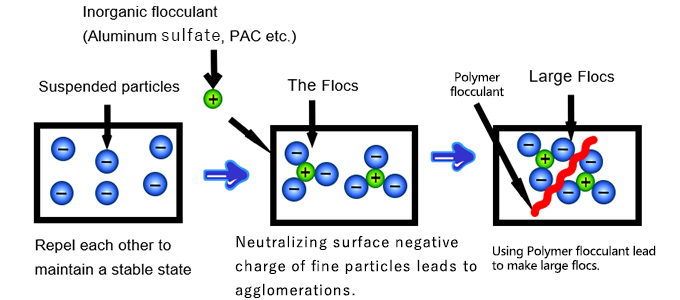

As global water scarcity intensifies and industrial pollution grows, the importance of effective wastewater treatment has never been greater. According to the 2023 UNESCO World Water Report, over 80% of wastewater globally is discharged untreated into the environment. This poses significant environmental and public health risks.
Among the various wastewater treatment methods—physical, biological, and chemical—chemical treatment plays a crucial role, especially in enhancing efficiency and handling complex contaminants.
This article explores essential wastewater treatment chemicals, their types, applications, and selection methods. We'll also explain the differences between wastewater treatment chemicals, water treatment chemicals, and WWTP chemicals—terms often used interchangeably but with distinct meanings in practice.

Purpose: Neutralize the charge on suspended particles so they can aggregate.
Inorganic Coagulants:
Aluminum Sulfate (Alum) – Widely used in municipal systems.
Poly Aluminium Chloride (PAC) – Offers higher efficiency and lower sludge volumes.
Organic Coagulants:
PolyDADMAC – Common in industrial wastewater for its fast-acting and strong cationic properties.
Purpose: Facilitate the formation of larger flocs from destabilized particles.
Synthetic Flocculants (Polyacrylamide - PAM):
Anionic PAM – For positively charged particles (e.g., metal oxides).
Cationic PAM – For organic-rich wastewater.
Non-Ionic PAM – For neutral-charge scenarios.
Natural Flocculants:
Chitosan and starch-based derivatives – Biodegradable and used in eco-sensitive applications.
Acids: Sulfuric acid, hydrochloric acid – Lower the pH.
Bases: Lime, sodium hydroxide – Raise the pH for optimal chemical activity and metal precipitation.
Chlorine and Sodium Hypochlorite – Common in municipal WWTPs.
Ozone and UV – Often used in advanced treatment stages.
Chlorine Dioxide – Effective against viruses and protozoa.
Phosphorus Removal Agents: Ferric chloride, alum, or lanthanum-based agents.
Heavy Metal Precipitants: Chelating agents for lead, mercury, chromium, etc.
Defoamers: Silicone or non-silicone-based for suppressing foaming in aeration tanks.
Municipal WWTPs often use coagulants and flocculants in primary and secondary treatment stages to remove suspended solids, reduce BOD/COD, and prepare water for biological treatment. Disinfectants like chlorine are used post-filtration to ensure safety before discharge or reuse.
Example: A city plant reduced PAC consumption by 25% using customized polymer blends, cutting sludge disposal costs significantly.
Industries face more complex effluent profiles requiring tailored chemical strategies:
Pulp & Paper: Alum and cationic PAM to remove lignin and fiber.
Electroplating: Sodium hydroxide and chelators for heavy metal removal (e.g., hexavalent chromium to trivalent).
Food Processing: Coagulation-flocculation to handle high oil and grease content.
In tailings management, flocculants are vital for separating solids and reclaiming process water. In oilfields, demulsifiers and non-ionic polymers break down oil-water emulsions effectively.
Choosing the right wastewater treatment chemicals depends on multiple factors:
Parameters: TSS, COD, BOD, pH, turbidity, ionic strength.
Methods: Jar testing, zeta potential analysis, pilot-scale simulation.
Primary Treatment: Focus on coagulants and flocculants.
Tertiary Treatment: Emphasize disinfection and nutrient removal.
Consider downstream impacts like sludge volume and filter clogging.
Analyze cost per unit treatment (e.g., $/kg of contaminant removed), not just chemical price.
Balance dosing rate, removal efficiency, and sludge handling costs.
Ensure chemical use aligns with:
EPA and REACH chemical restrictions.
ISO 14001 for environmental management.
Local discharge permit limits.
Problem: High-fat effluent disrupted biological treatment.
Solution: PAC + cationic PAM.
Result: COD removal increased by 85%, sludge volume reduced by 30%.
Problem: Emulsified oil hindered phase separation.
Solution: Custom demulsifier blend with non-ionic PAM.
Result: Achieved 99% oil removal and improved water recovery.
Q: Are wastewater treatment chemicals safe?
A: Yes, when used properly. Many are NSF/ANSI 60 certified for potable water use and environmentally approved for effluent discharge.
Q: How much do these chemicals cost?
A: Coagulants: $0.5–2/kg, Flocculants: $1–3/kg. Costs vary by dosage, formulation, and market region.
Q: Can treated sludge be reused?
A: Yes. With proper stabilization (lime + polymer), biosolids can be land-applied or used in reclamation projects.
The effective use of wastewater treatment chemicals is critical for regulatory compliance, environmental protection, and operational efficiency. From municipal plants to complex industrial effluents, the right combination of coagulants, flocculants, and specialty additives can dramatically improve treatment performance and reduce long-term costs.
Whether you're a plant operator, procurement manager, or environmental engineer, understanding and optimizing your wastewater chemicals strategy is essential. Partnering with a trusted supplier ensures access to high-purity, customized solutions designed for your specific needs.